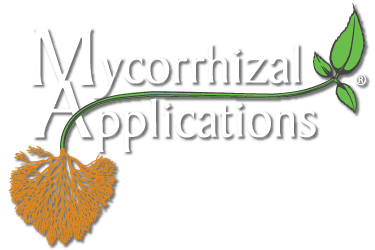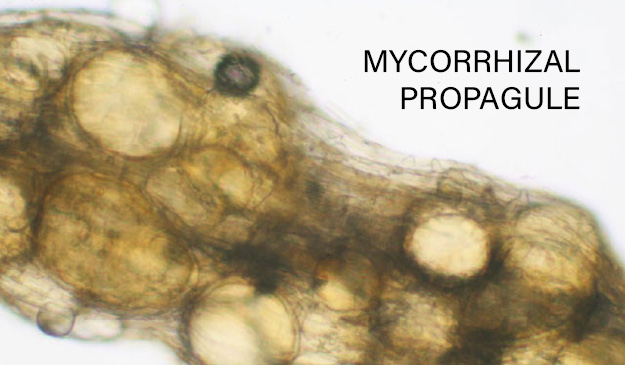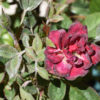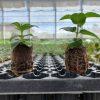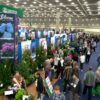Every couple of months when I choose a mycorrhizae topic to talk about, I often pick a topic that I have recently spoken with a grower about, or I am prompted by recent events (rise in fertilizer prices) to discuss. I try to choose a relevant, significant, and interesting topic that will cause growers to pause and seriously consider the use of MycoApply® mycorrhizae. This month, I have chosen to talk about the power of the mycorrhizae propagule. My intent is to clarify some questions and misunderstandings that I sometimes hear in the marketplace. This article will use both science and the law (state regulators) to support its content.
Background: About 80-85 percent of all plants are Endo mycorrhizal. This includes most greenhouse crops. About 5-10 percent of plants are Ecto mycorrhizal. This includes conifers (cone-bearing, not evergreen) and many hardwood trees. Most nurseries will either need an Endo/Ecto product or trial both an Endo and Ecto mycorrhizal product separately. Five to ten percent of all plants either need a specialty mycorrhiza not commercially available (Ericaceae and Orchidaceae) or the plants are non-mycorrhizal (Brassicaceae and Caryophyllaceae). The exact relationship of the plant and mycorrhizae type can be found on our website. If you know the plant’s family, genus, or common name, you should be able to determine the correct mycorrhizal pairing on this interactive tool.
Mycorrhizae live within the rhizosphere, a region of soil close to the root that can directly be influenced by root secretions and other microorganisms. The mycorrhizae form symbiotic (mutually beneficial) relationships with plants and expand the root absorptive area of the plant up to fifty times. The expansion of the root absorptive area can include more roots (only Ecto) but is more often the proliferation of a mycorrhizal hyphal network.
This relationship starts when the plant root senses the mycorrhizae propagule in the surrounding area and it releases an exudate to activate the mycorrhizae, which in turn grows and attaches to the plant root. The propagule needs to be a half inch (1.3 cm) or less from the growing root tip for symbiosis to initiate. Endo mycorrhizae physically enter the plant cell, hence “Endo” and Ecto mycorrhizae grow in between the plant cells, hence “Ecto”. Once attached, the mycorrhizae then start to develop a mycorrhizal hyphal network (root absorptive area) in the mineral soil or soil-less media. These hyphae are typically one-tenth the size of a root hair and can extend up to twenty-four inches (61 cm) beyond where they are attached to the root.
Both container-grown and field-grown plants benefit from a mycorrhizal association. This means the hyphae will expand throughout the container and capture a greater percentage of the available water and nutrients. Nutrient and water absorption occur along the entire length of the hyphae, as a pose to a root and root hair that only absorbs at the tip. With mycorrhizae hyphae mineral nutrient uptake occurs in the soluble and insoluble pool in the rhizosphere. Root and root hair uptake only occurs in the soluble nutrient pools. Due to the expansion of the root absorptive area, plants grown with mycorrhizae capture nutrients and water that the traditional plant root and root hair system would not have been able to physically secure since they did not extend to that portion of the soil. And finally, the rate of uptake is not limited like a root hair, leading to a greater inflow of water and nutrients with mycorrhizal hyphae. In summary, plants form symbiotic relationships with mycorrhizae to develop a more reliable source of nutrients and water; resulting in a healthier higher-quality plant for the grower to sell.
For this symbiotic process to happen, you need a mycorrhizal propagule. Understanding what a mycorrhizal propagule is crucial. Let me start by sharing with you two definitions.
“Endomycorrhizal fungal propagule – are the structures of endomycorrhizal fungi that are capable of forming a symbiotic association with plant roots. These structures are endomycorrhizal spores and root fragments colonized by endomycorrhizal fungi.”
“Ectomycorrhizal fungi propagule – is a structure of ectomycorrhizal fungi that is capable of forming a symbiotic association with plant roots. These structures are spores of ectomycorrhizal fungi.”
These two definitions were developed, approved, and accepted by the Association of American Plant Food Control Officials (AAPFCO). Who is AAPFCO? AAPFCO strives to gain uniformity and consensus amongst the U.S., Puerto Rican, and Canadian fertilizer regulatory programs. AAPFCO unites members through the promotion of uniform and effective legislation with concise definitions, rulings, and enforcement practices through the development of high standards of fertilizer inspection techniques, and through the promotion of proper labeling and safe use of fertilizers. AAPFCO’s membership includes regulatory agencies from all fifty states, Puerto Rico, and the federal government of Canada. These agencies are the ones that approve registration and labels for non-EPA products including mycorrhizae.
It is important to understand, an Endo mycorrhizal product can have both spores and colonized root fragments. An Ecto product can only have spores. The term propagule is a term only used when referring to Endo mycorrhizae. When a quality assurance test is done to determine the propagule count of an Endo mycorrhizal product, the laboratory technician does not count uncolonized root fragments or hyphae, they only count colonized root fragments and spores. This last sentence is a common misnomer often mentioned by some parties. Endo mycorrhiza does not only produce spores. A spore-only product must have colonized root fragments physically removed from the inoculum.
Spores are one of two long-term propagule formats produced by mycorrhizae. Colonized root fragments are the other long-term propagule format. The percentage breakdown of spores and colonized root fragments varies by genus/species and the environmental conditions the propagules were produced under. Considering commercial mycorrhizal products already have a two-year shelf life, in practicality there is no benefit in having a spore-only product.
However, there are several benefits from having a product that contains colonized root fragments. Colonized root fragments typically complete the symbiotic process sooner than spores. This fact is particularly important when a grower is growing a shorter-term crop (less than ten weeks). Annual growers benefit from using a product that contains colonized root fragment propagules.
As is true with many other microorganisms, numbers are critical for success. Unlike bacteria that typically decrease over time after application, mycorrhizae increase over time after application. Whatever concentration of mycorrhizae you apply initially, your concentration will increase as the plant grows and the mycorrhizae reproduce. Spore-only products typically have less propagules, compared with spore and colonized root fragment products. This results in again a slower response to initiating symbiosis, since the propagule needs to be within a half inch (1.3 cm) of the root tip for symbiosis to be initiated.
If you have any questions about the power of the propagule or MycoApply Mycorrhizae, please contact your local Mycorrhizal Applications Representative or call 866-476-7800 or email us at inquiries@mycorrhizae.com.
Article by: Blair Busenbark
Mycorrhizal Applications – Sales and Commercial Marketing Manager
November 8, 2023
